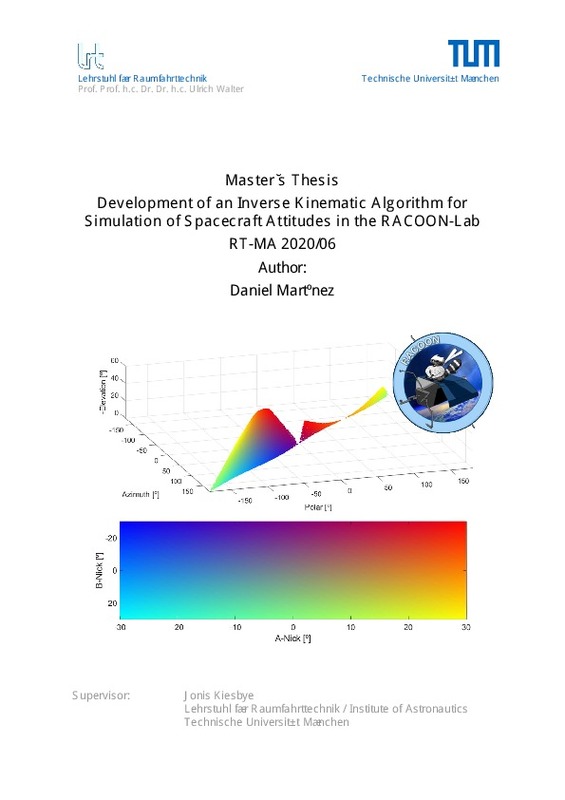JavaScript is disabled for your browser. Some features of this site may not work without it.
Buscar en RiuNet
Listar
Mi cuenta
Estadísticas
Ayuda RiuNet
Admin. UPV
Desarrollo de un Algoritmo de Cinemática Inversa para la Simulación de Actitud en Astronaves en el entorno RACOON-Lab
Mostrar el registro sencillo del ítem
Ficheros en el ítem
| dc.contributor.advisor | Pérez Martínez, Juan José
|
es_ES |
| dc.contributor.author | Martínez Sanchis, Daniel
|
es_ES |
| dc.date.accessioned | 2021-01-15T15:55:39Z | |
| dc.date.available | 2021-01-15T15:55:39Z | |
| dc.date.created | 2020-06-04 | |
| dc.date.issued | 2021-01-15 | es_ES |
| dc.identifier.uri | http://hdl.handle.net/10251/159169 | |
| dc.description.abstract | [ES] El entorno RACOON-Lab (Robotic Actuation and On-Orbit Navigation Laboratory) fue concebido para testar las interacciones entre diferentes astronaves en órbita. Se compone de dos diferentes cuerpos: El Perseguidor y el Objetivo. La actitud de el Objetivo está determinada por 5 grados de libertad, de los cuales sólo dos son ilimitados (azimut y polar). Los ángulos de cabeceo están limitados a tan sólo ± 30º y el ángulo de elevación está limitado a poco más de la mitad de una rotación completa, en la llamada configuración en C-RIng. Esta configuración actual tiene muchas aplicaciones potenciales como banco de pruebas para algoritmos avanzados de reconocimiento visual en aplicaciones espaciales. A diferencia de un anillo cerrado, esta disposición tiene la posibilidad de recrear un campo visual libre de obstáculos entre el Perseguidor y el Objetivo. Sin embargo, esta configuración se ha revelado extremadamente compleja desde el punto de vista de la cinemática inversa. El desarrollo de un algoritmo capaz de resolver de un modo eficiente la cinemática inversa es un paso necesario para la explotación completa de las posibilidades del entorno RACOON-Lab. EL presente proyecto persigue el desarrollo de un algoritmo funcional, que dadas las trayectorias deseadas, proporcione automáticamente las entradas óptimas en los diferentes actuadores de el Objetivo. Esto permitirá a los robots de la instalación representar movimientos orbitales de un modo realista, sin renunciar a los beneficios de la configuración C-Ring. | es_ES |
| dc.description.abstract | [EN] The RACOON-Lab (Robotic Actuation and On-Orbit Navigation Laboratory) facility was conceived to test the interactions between different spacecraft in orbit. It is composed of two different bodies: the Chaser anthe a Target. The attitude of the Target is determined by 5 degrees of freedom, from which only 2 are unlimited (Azimuth and Polar). The nick angles are limited to only ± 30º and the elevation angle is additionally limited to about only the half of the complete rotation, in the so-called C-Ring configuration. This current configuration has many potential applications as a test bed for advanced visual recognition algorithms in space applications. Unlike a closed ring, this disposition has the possibility to recreate a clear visual field between the chaser and the rotor. However, this configuration has revealed to be extremely challenging from the point of the inverse kinematic. The development of an algorithm, that efficiently resolves the inverse kinematic for realistic orbital behaviors is a necessary step for the fully exploitation of the RACOON-Lab capabilities. The present project aims to develop a functional algorithm, that given desired trajectories, automatically provides optimal inputs for the different actuators in the Target. This will allow the current robots in the facility to represent realistic orbital movements of different spacecraft, without renouncing to the potential advantages of the C-Ring Configuration. | es_ES |
| dc.format.extent | 133 | es_ES |
| dc.language | Inglés | es_ES |
| dc.publisher | Universitat Politècnica de València | es_ES |
| dc.rights | Reserva de todos los derechos | es_ES |
| dc.subject | Robótica | es_ES |
| dc.subject | Cinemática inversa | es_ES |
| dc.subject | Control | es_ES |
| dc.subject | Actitud | es_ES |
| dc.subject | Automatización | es_ES |
| dc.subject | Satélites | es_ES |
| dc.subject | Espacio | es_ES |
| dc.subject | Robotics | es_ES |
| dc.subject | Inverse kinematics | es_ES |
| dc.subject | Attitude | es_ES |
| dc.subject | Automation | es_ES |
| dc.subject | Satellites | es_ES |
| dc.subject | Space | es_ES |
| dc.subject.classification | TECNOLOGIA ELECTRONICA | es_ES |
| dc.subject.other | Máster Universitario en Ingeniería Industrial-Màster Universitari en Enginyeria Industrial | es_ES |
| dc.title | Desarrollo de un Algoritmo de Cinemática Inversa para la Simulación de Actitud en Astronaves en el entorno RACOON-Lab | es_ES |
| dc.type | Tesis de máster | es_ES |
| dc.rights.accessRights | Abierto | es_ES |
| dc.contributor.affiliation | Universitat Politècnica de València. Departamento de Ingeniería Electrónica - Departament d'Enginyeria Electrònica | es_ES |
| dc.contributor.affiliation | Universitat Politècnica de València. Escuela Técnica Superior de Ingenieros Industriales - Escola Tècnica Superior d'Enginyers Industrials | es_ES |
| dc.description.bibliographicCitation | Martínez Sanchis, D. (2020). Desarrollo de un Algoritmo de Cinemática Inversa para la Simulación de Actitud en Astronaves en el entorno RACOON-Lab. Universitat Politècnica de València. http://hdl.handle.net/10251/159169 | es_ES |
| dc.description.accrualMethod | TFGM | es_ES |
| dc.relation.pasarela | TFGM\115214 | es_ES |
Este ítem aparece en la(s) siguiente(s) colección(ones)
-
ETSII - Trabajos académicos [10404]
Escuela Técnica Superior de Ingenieros Industriales






